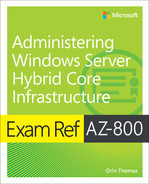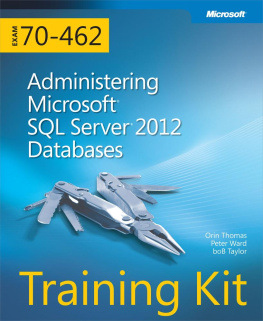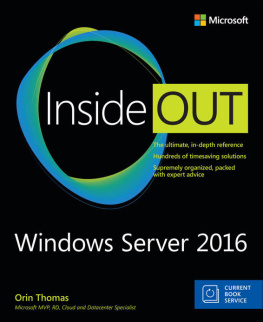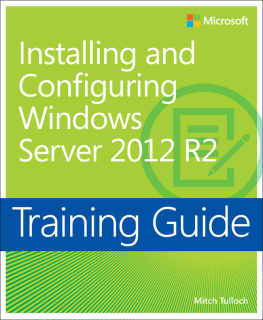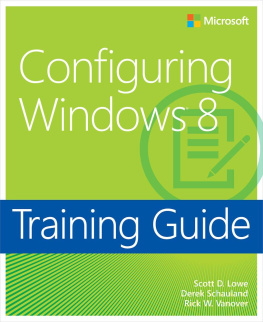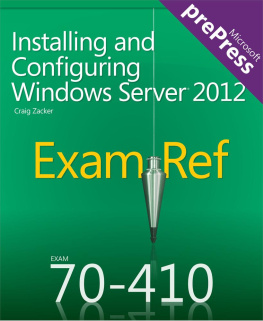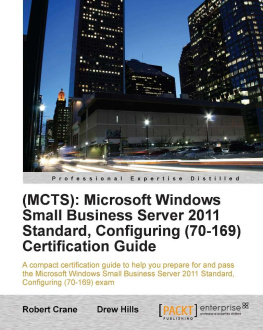Training Guide: Configuring Advanced Windows Server 2012 Services
Orin Thomas
Published by Microsoft Press
Special Upgrade Offer
If you purchased this ebook directly from oreilly.com, you have the following benefits:
DRM-free ebooksuse your ebooks across devices without restrictions or limitations
Multiple formatsuse on your laptop, tablet, or phone
Lifetime access, with free updates
Dropbox syncingyour files, anywhere
If you purchased this ebook from another retailer, you can upgrade your ebook to take advantage of all these benefits for just $4.99. to access your ebook upgrade.
Please note that upgrade offers are not available from sample content.
Introduction
When Microsoft puts together exam objectives for an exam, it doesnt randomly select pages from TechNet. Instead, in conjunction with subject matter experts and representatives of the product team, it puts together a list of tasks and areas of knowledge that represents what someone in a specific job role would do and need to know on a day-to-day, a weekly, or even a monthly basis.
Each exam maps to a different job role. The objectives for the 70-412 exam are a list of tasks and areas of knowledge that describe what an advanced administrator of the Windows Server 2012 operating system with several years of on-the-job experience (managing other server operating systems as well as Windows Server 2012) does and understands. These topics include some that experienced administrators may not have encountered before or have limited experience with, such as Active Directory Rights Management Services and Active Directory Federation Services.
This book covers the majority of the topics and skills that are the subject of the Microsoft certification exam 70-412. The idea behind this book is that by reading it and by performing the extensive practice exercises at the end of each chapter in your own lab, you can learn how to perform tasks with the technologies addressed by the exam. By performing the tasks yourself in a test environment, youll learn enough about how these technologies work that youll be able to leverage that knowledge in your real-world role as a Windows Server 2012 administrator. Reading and performing the lab exercises in this book will assist you in preparing for the exam, but its not a complete exam preparation solution. If you are preparing for the exam, you should use additional study materials, such as practice tests and the forthcoming Exam Ref 70-412: Configuring Advanced Windows Server 2012 Services to help bolster your real-world experience.
By using this training guide, you will learn how to do the following:
Configure and manage high availability
Configure file and storage solutions
Implement business continuity and disaster recovery
Configure network services
Configure the Active Directory infrastructure
Configure identity and access solutions
System requirements
The following are the minimum system requirements your computer needs to meet to complete the practice exercises in this book. This book is designed assuming you will be using Hyper-Veither the client version available with some editions of Windows 8 or the version available in Windows Server 2012. You can use other virtualization software instead, such as VirtualBox or VMWare Workstation, but the practice setup instructions later in this introduction assume that you are using Hyper-V.
Hardware and software requirements
This section presents the hardware requirements for Hyper-V and the software requirements.
Virtualization hardware requirements
If you choose to use virtualization software, you need only one physical computer to perform the exercises in this book, except for in , which requires two identical computers. The physical host computer must meet the following minimum hardware requirements:
x64-based processor that includes both hardware-assisted virtualization (AMD-V or Intel VT) and hardware data execution protection. (On AMD systems, the data execution protection feature is called the No Execute or NX bit. On Intel systems, this feature is called the Execute Disable or XD bit.) These features must also be enabled in the BIOS. (Note: You can run Windows Virtual PC without Intel-VT or AMD-V.) If you want to use Hyper-V on Windows 8, you need a processor that supports Second Layer Address Translation (SLAT).
8 gigabytes (GB) of RAM (more is recommended).
250 GB of available hard disk space.
Internet connectivity.
Software requirements
The following software is required to complete the practice exercises:
Virtual machine setup instructions
This set of exercises contains abbreviated instructions for setting up the SYD-DC, MEL-DC, ADL-DC, and CBR-DC computers used in the practice exercises in all chapters of this training kit. To perform these exercises, first install Windows Server 2012 Standard edition using the default configuration, setting the administrator password to Pa$$w0rd.
Exercise 1 SYD-DC to function as a Windows Server 2012 domain controller
Log on to the first computer on which you have installed Windows Server 2012 using the Administrator account and the password Pa$$w0rd.
Open an elevated PowerShell prompt and issue the following command:
cmdEnter the following command:
Netsh interface ipv4 set address "Ethernet" static 10.10.10.10Enter the following command:
netdom renamecomputer %computername% /newname:SYD-DCRestart the computer and log back on using the Administrator account.
Open an elevated PowerShell prompt and issue the following command:
Add-WindowsFeature AD-Domain-Services -IncludeManagementToolsOpen the Server Manager console. Click the Refresh icon.
Click on the Notifications icon and then click Promote This Server to Domain Controller.
On the Deployment Configuration page, choose Add a New Forest. Enter Contoso.com as the root domain name and then click Next.
On the Domain Controller Options page, configure the following settings and then click Next:
Forest Functional Level: Windows Server 2012
Domain Functional Level: Windows Server 2012
Specify Domain Controller Capabilities:
DSRM Password: Pa$$w0rd
On the DNS Options page, click Next.
On the Additional Options page, click Next.
Accept the default settings for the Database, Log Files, and SYSVOL locations and click Next.
On the Review Options page, click Next.
On the Prerequisites Check page, click Install.
The computer will restart automatically.
Exercise 2 Prepare Active Directory Domain Server (AD DS)
Log on to server SYD-DC using the Administrator account.
Using Active Directory Users and Computers, create a user account named don_funk in the Users container and assign the account the password Pa$$w0rd. Configure the password to never expire. Add this user account to the Enterprise Admins, Domain Admins, and Schema Admins groups.


